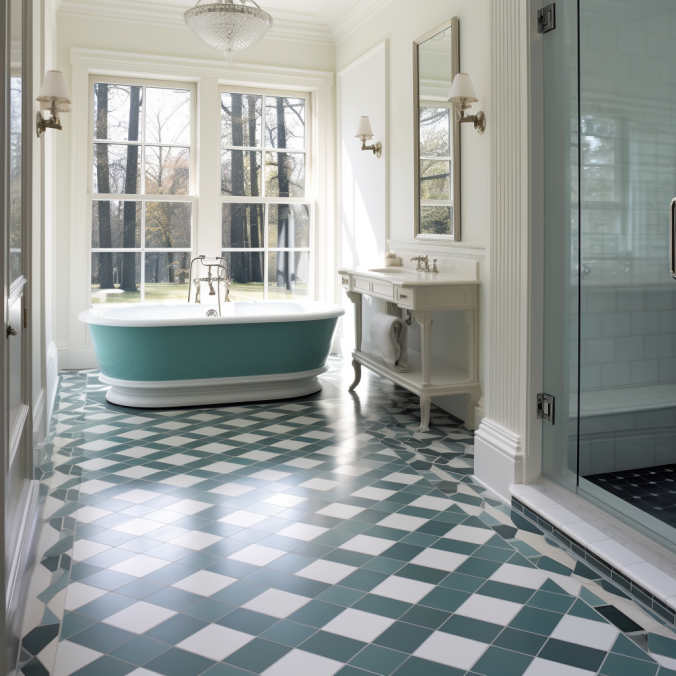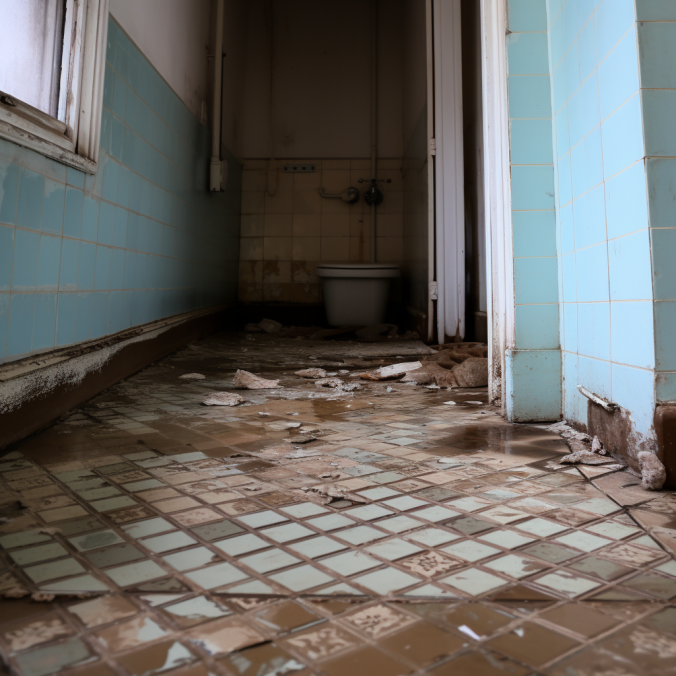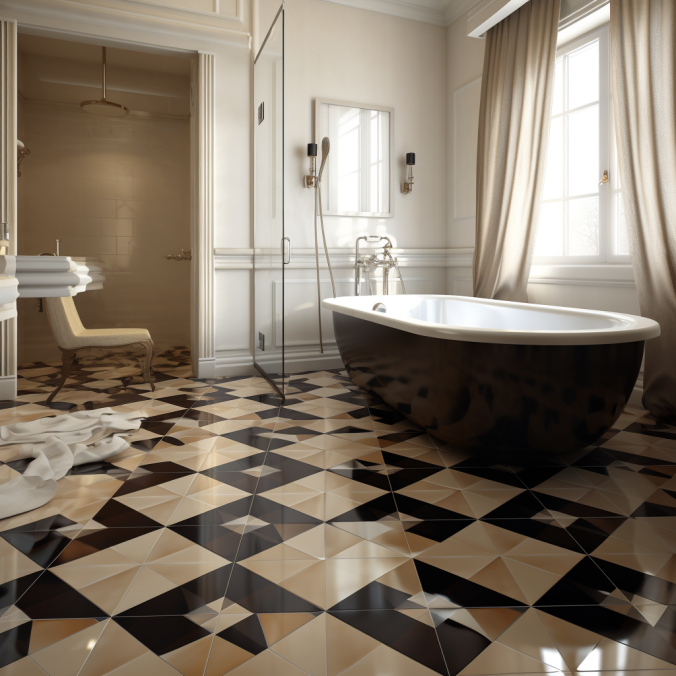Importance of a well-designed bathroom floor
The bathroom floor plays a crucial role in the overall design and functionality of the space. Its size should be considered to ensure that it complements the size of the bathroom and doesn't make the space feel cramped or empty. The style of the floor should also reflect the overall aesthetic of the bathroom, whether it's modern, traditional, or eclectic. Of course, budget is a crucial factor when considering flooring options, as it should be durable and cost-effective.
The flooring choice can greatly impact the look and feel of the bathroom. For instance, a light-colored, sleek tile can make the space feel open and airy, while a darker, textured floor may add a sense of warmth and coziness. In terms of functionality, the flooring material should be waterproof and easy to clean, making maintenance a breeze.
When choosing bathroom flooring, key considerations include durability, water resistance, slip resistance, and ease of maintenance. Various materials such as ceramic or porcelain tile, vinyl, natural stone, and even wood can be used to create a stylish and functional bathroom floor. Each has its own pros and cons, so it's essential to weigh them against the specific needs of the space. Ultimately, a well-designed bathroom floor can elevate the entire ambiance of the room.
Planning and Preparation
Planning and Preparation are essential elements of achieving success in any endeavor. Whether it's organizing a big event, starting a new project, or embarking on a journey, careful planning and thorough preparation are key to ensuring everything runs smoothly and efficiently. In this section, we will explore the importance of planning and the steps involved in preparing for various situations. From creating detailed schedules and timelines to gathering the necessary resources and information, effective planning and preparation are critical for setting yourself up for success. We will delve into the strategies, tools, and techniques that can help you streamline your planning process and ensure that you are thoroughly prepared for whatever may come your way. So, let's jump into the world of planning and preparation and discover the benefits of being organized and ready for what lies ahead.
Assessing the current condition of the bathroom
The current condition of the bathroom is generally functional but in need of some updates. The layout consists of a single vanity, a shower stall, and a toilet, with the fixtures showing signs of wear and tear. The tiles are outdated and there are some signs of mold and mildew in the shower area. The vanity is old and worn, and the toilet has a tendency to run.
Before beginning the renovation process, the tiles will need to be replaced, the shower stall re-grouted, and the fixtures updated. The vanity and toilet will also need to be replaced due to their condition.
Specific measurements for the new design will include the dimensions of the bathroom space, the size of the current fixtures, and the layout for potential new fixtures.
Potential obstacles include the presence of mold and mildew, the need for plumbing updates, and potential structural issues with the shower area. These will need to be addressed during the renovation process to ensure a successful and long-lasting update.
Determining the budget for the project
When determining the budget for your DIY bathroom remodel, it is essential to consider all potential expenses. This includes materials such as stone, tile, and plumbing fixtures, as well as labor costs if you plan to hire professionals for certain tasks. Additionally, permits may be required for specific renovations, so be sure to account for those fees as well.
It's important to also factor in potential unexpected costs, such as finding water damage or needing to hire a professional for technical work like electrical or plumbing. Additional features, such as body sprays or heated floors, should also be included in your budget.
When creating your budget, consider potential delays or extra time needed for tasks. It's always wise to allocate a portion of your budget for contingencies to cover any unforeseen costs or project changes. By carefully estimating expenses for materials, labor, permits, and potential unexpected costs, you can ensure that your DIY bathroom remodel stays within your budget constraints.
Researching different flooring materials
When researching different bathroom flooring materials, the most popular options to consider are tile, laminate, wood, and vinyl.
Tile is a popular choice for bathroom flooring due to its durability, water resistance, and easy maintenance. It comes in a variety of styles, colors, and patterns, allowing for a customized look. Laminate flooring is cost-effective and easy to install, with a moisture-resistant layer that makes it suitable for bathrooms. Wood flooring adds warmth and elegance to a bathroom, but it requires more maintenance and is less water-resistant than other options. Vinyl flooring is budget-friendly, durable, water-resistant, and comes in a wide range of styles.
When selecting the best flooring for a bathroom remodel, it's important to consider factors like heat-conduciveness and water resistance. For instance, tile and vinyl are heat-conducive, making them suitable for underfloor heating systems. Water resistance is crucial to prevent damage from moisture and spills, making tile, laminate, and vinyl good choices for bathroom flooring.
In conclusion, researching and considering the key features and benefits of bathroom flooring materials is essential when choosing the best option for a bathroom remodel. Key factors to consider include heat-conduciveness and water resistance.
Choosing a color scheme
When choosing a color scheme for your bathroom, it is essential to consider the recommended eggshell finish and its moisture-repelling properties. Start by considering the overall mood you want to achieve in your bathroom. For a calming spa-like atmosphere, consider soft, natural colors such as pale blues, greens, or earthy tones. If you want a more energizing and vibrant space, opt for brighter colors like yellows or oranges.
When selecting colors, keep in mind the moisture-repelling properties of the eggshell finish. This finish is ideal for bathrooms as it helps to resist moisture and is easy to clean. Choose colors that will complement this finish and stand up to the humid environment of a bathroom.
Incorporate the top 5 most relevant keywords by considering the color scheme, bathroom, eggshell finish, moisture-repelling, and paint selection. When selecting paint for your bathroom, be sure to choose colors that work well with the moisture-repelling properties of the eggshell finish. This will ensure that your chosen color scheme not only looks great but also stands up to the demands of the bathroom environment.
Removing the Existing Flooring
When it comes to renovating a space, one of the first steps is often removing the existing flooring. Whether it's worn-out carpet, outdated tile, or damaged hardwood, taking out the old flooring is necessary before installing something new. This process can be labor-intensive and time-consuming, but it's an essential step to creating a fresh, updated look for a room. In this section, we will discuss the steps and considerations for removing different types of flooring, as well as tips for making the process as efficient and smooth as possible. Whether you're a DIY enthusiast or hiring a professional, understanding the best techniques for removing existing flooring will set the stage for a successful renovation project.
Removing old tiles or vinyl flooring
When it comes to removing old tiles or vinyl flooring, it is essential to start by wearing proper protective equipment such as gloves and safety goggles, as well as having a floor scraper on hand. These will help protect you from any sharp edges, debris, or adhesive residue.
To begin the removal process, carefully lift and dispose of the old tiles or vinyl flooring. Be sure to work methodically to avoid creating unnecessary mess or damage. Once the flooring is removed, use the floor scraper to carefully scrape away any remaining adhesive or residue from the subfloor.
After removing the old flooring and cleaning the subfloor, it is crucial to properly prepare the subfloor for the installation of new flooring. This includes ensuring the surface is smooth, clean, and free of any debris or adhesive residue. Properly preparing the subfloor will help ensure that the new flooring will be installed on a flat and even surface, reducing the risk of any future issues or damage.
In summary, when removing old tiles or vinyl flooring, it is important to have protective equipment and the right tools, including a floor scraper. Take care when removing the old flooring and properly prepare the subfloor for the installation of new flooring to achieve the best results.
Dealing with water damage and repair work
When dealing with water damage in a bathroom refitting project, the first step is to assess the extent of the damage. This involves identifying any affected areas that require repair, such as water-damaged walls, floors, or cabinets. Once the assessment is complete, prioritize the repair work based on the severity of the damage. Address any immediate safety concerns and structural issues first before moving on to cosmetic repairs.
Proper waterproofing measures should also be implemented during the repair work to prevent future water damage. This may include sealing grout lines, using waterproof membranes, and installing water-resistant materials. Ensuring that the bathroom is properly waterproofed will help to prevent any future issues with water damage.
In conclusion, when dealing with water damage in a bathroom refitting project, it is important to assess the damage, prioritize the repair work, and implement proper waterproofing measures. By following these necessary steps, you can effectively address water damage and ensure that the bathroom is repaired and protected from future issues.
Preparing the Subfloor
Before installing any type of flooring, it is crucial to properly prepare the subfloor to ensure a smooth and durable surface. A well-prepared subfloor will help to prevent future issues with the flooring such as buckling, uneven surfaces, and premature wear and tear. By following the necessary steps to prepare the subfloor, you can ensure that your flooring installation will be successful and long-lasting.
Inspecting subfloor for any damage or issues
When inspecting the subfloor, it is crucial to thoroughly check for any signs of damage that may compromise its integrity. Use a flashlight to shine light on hard-to-reach areas such as corners and edges to ensure all areas are properly examined. Look for any warping, water stains, or rot, as these are clear indications of damage to the subfloor. Additionally, be on the lookout for any uneven spots or squeaky areas, as they may also suggest underlying issues with the subfloor.
Inspecting the subfloor is an essential step in ensuring the stability and longevity of the flooring above. Identifying and addressing any damage or issues with the subfloor will prevent further problems and maintain the structural integrity of the entire flooring system. By conducting a thorough subfloor inspection, any potential hazards or concerns can be promptly addressed, ensuring a safe and secure foundation for the flooring above.
Installing cement board for added stability
Installing cement board is a crucial step in adding stability and durability to any surface before tiling. To begin, ensure the surface is clean and dry to promote proper adhesion. Measure and cut the cement board to fit the area, leaving a small gap between the boards to allow for expansion. Next, attach the board securely using the appropriate screws or adhesive to ensure a stable and long-lasting installation.
In areas where moisture is a concern, it is important to apply a waterproofing membrane before installing the cement board. This extra layer of protection will help prevent any water damage and ensure the longevity of the installation.
Overall, the installation of cement board is a straightforward process that greatly improves the stability and longevity of any surface before tiling. By following these steps and considering factors such as surface preparation, waterproofing, and stability, you can achieve a successful and durable cement board installation.
Selecting the Right Flooring Material
Choosing the right flooring material for your home or business is a crucial decision that can greatly impact the overall look and feel of the space. The right flooring not only enhances the aesthetics of the room but also provides functionality and durability. With so many options available in the market, it's important to carefully consider factors such as the purpose of the space, foot traffic, maintenance requirements, and budget before making a decision. From hardwood and laminate to vinyl and tile, each flooring material has its own set of advantages and disadvantages. By understanding the unique characteristics of each option, you can make an informed decision that best suits your needs and style preferences. In this section, we will explore the various flooring materials available and provide insights to help you make the right choice for your next flooring project.
Exploring different options for bathroom floors
When exploring different options for bathroom floors, there are several materials to consider. Porcelain and ceramic tiles are popular choices for their waterproofness and durability, making them ideal for bathrooms. They come in a wide array of designs, allowing for various aesthetic appeals. Stone tiles also offer a waterproof and durable option with a natural, elegant look, but they may be pricier.
On the other hand, vinyl is a budget-friendly and waterproof option, but it may not be as durable as the aforementioned materials. Wood and laminate are aesthetically appealing and versatile, but they may not be as waterproof, so they require more maintenance in a bathroom environment.
When making a decision, consider the size and budget of your space. Porcelain and ceramic tiles are suitable for larger budgets and provide high waterproofness and durability. Stone tiles are also a great option for larger budgets. Vinyl, wood, and laminate are more budget-friendly options but may require more maintenance. Ultimately, the best choice for your bathroom floor will depend on your specific needs, budget, and aesthetic preferences.


